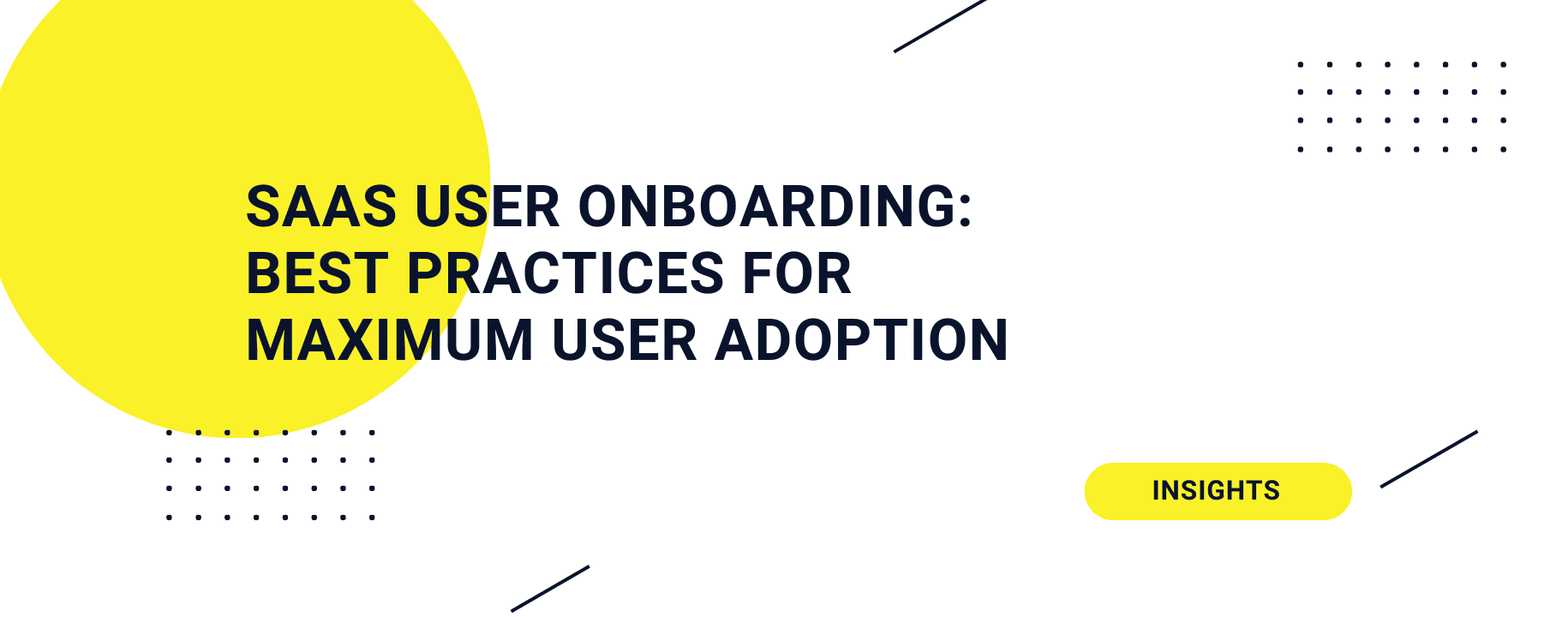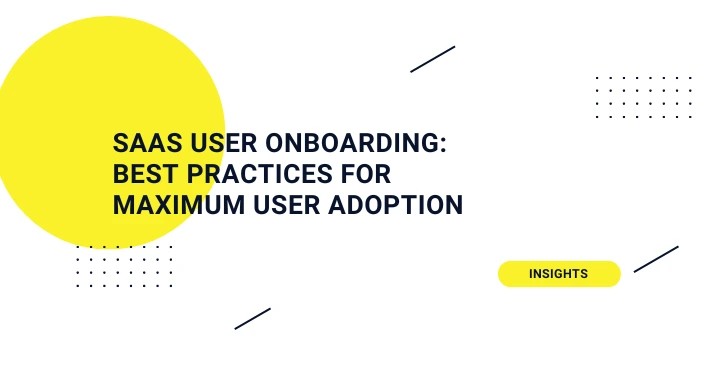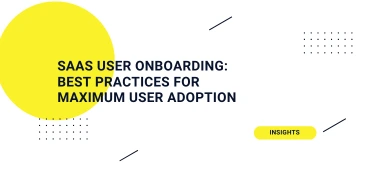- Industry insights
- 26 Feb 2025
SaaS User Onboarding: Best Practices for Maximum User Adoption
Discover the best practices for SaaS onboarding to ensure maximum user adoption. Learn how to create a seamless & engaging experience!



Table of contents
Contributors

Introduction
Saas User Onboarding is often seen as a simple technical step that any application must have. We aim to shift this perspective by emphasizing that onboarding is not just a component, but a strategy that, if done well, will lead to a loyal customer base, boosting satisfaction and reducing churn.
In this article, we’ll explore the best practices for effective onboarding so that you maximize your chances of turning new users into loyal customers.
Understanding SaaS User Onboarding
Effective onboarding helps users quickly understand the value of your product, turning them into active and loyal customers. It’s the first impression the user makes when coming in contact with your product and, like any other first impression, it matters. In turn, for you and the company, the onboarding process is the chance to demonstrate that the product is valuable, thus encouraging long-term user engagement.
The main objectives of SaaS user onboarding are:
- Smooth transition: Helping users quickly understand how to use the platform
- Presenting product value: Making it easy for users to understand product benefits and features.
- Increasing engagement: Encouraging users to interact with features, promoting continued use.
- Reducing churn: A well-designed onboarding process supports users, increasing their likelihood of sticking around.
- Build loyalty: A positive onboarding experience helps establish trust, leading to long-term customer loyalty.
- Maximize conversions: Turning new users into paying or active customers, driving revenue growth.
3 SaaS Onboarding Models
1. Self-Serve Onboarding
This model assumes that users can navigate on their own. You provide a structured onboarding experience, like an introductory guide or tutorial, and then give users the freedom to navigate and interact with the product. The model is more suited to simple, intuitive, and easy-to-use applications.
In general, for more complex SaaS platforms, self-service onboarding may not be enough. Therefore, we now move on to the following two models.
2. Low-Touch Onboarding
This model builds on the principles of self-serve onboarding while offering additional support, such as automated emails, chatbots, or pre-recorded onboarding sessions. Also, with low-touch onboarding, users have access to some human support options, but there is no dedicated, one-on-one support. This model is suitable for more complex applications than self-serve onboarding, which offers more functionality but is easy to use once the user understands the basics.
Zoom, Mailchimp, and Canva – All use low-touch onboarding principles.
3. High-Touch Onboarding
This model is used for complex products that require more time and personalized interaction to reach the optimal level of usability. It involves direct interactions with support teams and account managers, and onboarding is often personalized for each user.
Salesforce, for example, has a High-Touch Onboarding because it requires specific configuration based on each company’s requirements and offers complex customization options that require specialized help.
Best Practices for an Effective SaaS Onboarding Process
1. Make Sign-up Easier
Let’s face it. We live in a fast-paced world where we want everything to happen as fast as possible, including signing up for an app. People lose interest if they have to go through a long, complicated process to create an account. Often, they’re interested in the product but abandon it when faced with too many steps.
The best solution here is to have a sign-up area with other existing accounts (Google, Facebook, or Linkedin). According to userpilot.com, this can increase conversion rates by up to 40%.
Also, by adding calls to action like ‘Sign-up in seconds,’ we reinforce the idea that the sign-up process is simple and quick.
2. Personalize The Greeting Messages
We all feel special when we are given dedicated attention. So, as soon as the user has created an account, greet them with a personalized message. In this way, you make the user feel valued, reassuring them that choosing your product was the right decision.
Another important aspect is ensuring that the welcome message comes from a real person, rather than a robot. The human warmth conveyed in the message reinforces the idea of personalization and, on a psychological level, creates a sense of authenticity and connection (see Userlist example below).
You can also send a warm and friendly welcome email. Let’s take the Mailchimp example below, which creates a sense of belonging to the user by: 1) expressing appreciation for the user’s presence, 2) reinforcing the concept of the Mailchimp community.
3. Use a Customized Onboarding Survey
After welcoming the user, the next step is to understand their needs and objectives—essentially, their reason for choosing your product. A tailored onboarding experience allows us to give them the necessary tools while ensuring they don’t spend time on irrelevant features.
For example, Otta’s recruitment platform uses surveys to collect information about users’ professional preferences, providing personalized job recommendations.
It is extremely important that the survey only covers the initial aspects because if it is too long, it increases the likelihood of user abandonment. Additionally, once we have gathered the necessary information, we shouldn’t overwhelm the user with excessive details or features. Instead, we should guide them gradually, introducing more complex features at a later stage.
4. Use an Interactive Product Tour
According to the Learning Pyramid, only 10% of information is retained by reading, while 75% is retained by doing. So when guiding users through your product, make it interactive! That way, the user can get used to each feature.
It’s also important to always have a skip button, for those users who want to learn on their own or go through the process later (see Slack example below).
Additionally, every time you make an update and introduce a new feature, notify the user but offer them the option to explore it later. This prevents overwhelming them with too much information while giving them a sense of autonomy and control. It also reassures them that resources are available whenever they choose to dive deeper.
5. Offer Encouragement and Reinforcement of Desired Behavior
When the user understands a tool correctly, celebrate this small win with token rewards. In learning psychology, this is called positive reinforcement of the desired behavior by offering positive stimuli. An excellent example is the Duolingo app, which gives you dots, hearts, and even words of praise when you complete a lesson.
6. Provide Continuous Support and a Resource Database
The user needs to know that they have a learning database available to them whenever they need it. This database can include small guides, short tutorial videos, or even full courses. This attracts 2 important categories of your audience: 1) those who are using the product and want to improve their skills by learning new features, and 2) those who haven’t used the product yet, but see that they can learn it with the help of these materials you provide.
Canva, for instance, has a dedicated educational database called Canva Design School, which includes tutorials and user guides, teaching users how to use Canva tools effectively.
7. Gather User Feedback and Take Action
To know what works well and what doesn’t with your product, it’s best to ask the people who use it. Gather information in the final part of the onboarding process to make sure the user has interacted enough with your product and can give you valuable insights.
There are two popular methods for collecting feedback: in-app surveys and email surveys. The in-app survey option typically has a higher response rate and is preferable because users can respond while using the app. Additionally, feedback questionnaires should be short, ideally between 3-5 questions, and should not take too long to answer; otherwise, users may give up.
It’s also important to help the user realize that their feedback is not only valuable to you but also to them, as it helps provide the best possible experience. This way, you’re fostering a sense of collaboration and mutual benefit.
8. Track User Engagement
Tracking user engagement helps you understand which users have figured out each feature and which ones need help, so you can guide them further. On the other hand, it also gives you insights into the onboarding process: if more users are getting stuck on a particular step, maybe it’s time to revise that step.
Customer Success Onboarding Metrics
According to wesoftyou.com, there are 3 main indicators you should consider:
User Activation Rate
This indicator shows you what percentage of your users have completed the essential onboarding steps. If this rate is low, it means the process could be improved.
A useful tool for tracking this metric is Userpilot.
Time to First Value
This metric measures how long it takes users to understand and benefit from the functionality of your product. If the time is too long, it may mean that onboarding is too complex or confusing. You can use Hotjar or Pendo to track this.
User Drop-off Rate
This indicator shows you what percentage of your users give up before the onboarding process is complete. If you see high abandonment at a certain point, it means that the step is difficult or it takes too long to complete. By identifying where problems occur, you can improve the process. Tools like Amplitude or Userpilot can help you monitor this.
Conclusion
In conclusion, user onboarding in SaaS is first and foremost an essential strategy that helps us build a solid base of loyal customers, create a positive experience, and maximize product success.
Let us take a look at your SaaS product! Get a free UI/UX analysis and make your onboarding smoother than ever. Get in touch with us!
The CTO Insights Initiative | Felix Crisan – Netopia
Retention Engineering: Data-Driven Strategies to Reduce Churn in SaaS Products
Designing for Conversion: UX Principles That Transform SaaS Trial Users Into Paying Customers